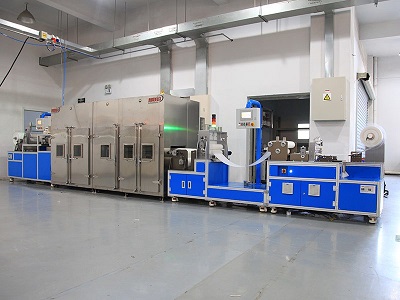Wood, a natural and renewable resource, has been a staple in construction and furniture making for centuries. However, its susceptibility to decay, fungi, and insect infestation has always been a concern. The process of pressure impregnation offers a solution to these issues, significantly enhancing the wood's durability and resistance to environmental threats. This article explores the full auto impregnating process, a state-of-the-art technique that ensures deep and uniform treatment for a wide range of wood products.

I. Introduction to Pressure Impregnation
Pressure impregnation is a chemical treatment that infuses wood with preservatives under high pressure. This process ensures that the wood is protected against biological degradation, making it suitable for outdoor applications and structural uses where durability is paramount.
II. The Significance of Full Auto Impregnation
Full auto impregnation by drying is a fully automated process that not only impregnates the wood with preservatives but also dries it to the desired moisture content. This dual function is crucial for the production of high-quality, long-lasting wood products that can withstand various environmental conditions.
III. The Full Auto Impregnation Process
The full auto impregnation process involves several key steps:
Pre-Treatment: The wood is first debarked and cleaned to remove any dirt or debris that might interfere with the impregnation process.
Drying: Full auto impregnation by drying removes excess moisture from the wood, preparing it for the treatment process. This step is vital as it ensures that the preservatives can penetrate the wood fibers more effectively.
Vacuum Stage: The wood is placed in a vacuum chamber where the air is removed, creating a low-pressure environment that allows the preservatives to be drawn deep into the wood.
Pressure Impregnation: After the vacuum stage, the chamber is filled with a preservative solution. The high pressure forces the solution into the wood, ensuring a uniform distribution of the preservatives throughout the material.
Post-Treatment: Once the wood is fully impregnated, it is subjected to a post-treatment process that includes a second round of full auto impregnation by drying to ensure that the preservatives are set within the wood and any excess is removed.
Quality Control: The treated wood undergoes rigorous testing to ensure that it meets the required standards for durability and protection against decay and insects.
IV. Benefits of Full Auto Impregnation
Full auto impregnation by drying offers several advantages:
Uniform Treatment: The process ensures that every part of the wood is treated equally, providing a consistent level of protection.
Efficiency: Automation streamlines the process, reducing the time and labor required for treatment.
Environmental Control: By controlling the moisture content and chemical exposure, the process minimizes environmental impact.
Enhanced Durability: The treated wood exhibits increased resistance to decay, fungi, and insect infestation, extending its service life.
V. Applications of Pressure Impregnation
The full auto impregnation process is widely used in various industries:
Construction: Treated wood is used for outdoor decking, fencing, and structural components.
Marine: The process is ideal for applications in docks, piers, and other marine structures exposed to water and salt.
Telecommunications: Utility poles and crossarms treated through full auto impregnation by drying resist decay and insect damage, ensuring the stability of communication networks.
VI. Challenges and Solutions
While the full auto impregnation process offers numerous benefits, it also faces challenges such as the development of chemical-resistant fungi strains and environmental concerns regarding the use of certain preservatives. Ongoing research and development are focused on finding eco-friendly preservatives and improving the process to address these challenges.
VII. The Future of Full Auto Impregnation
As the demand for sustainable and durable wood products grows, the full auto impregnation process is expected to evolve. Innovations in automation, the use of nanotechnology, and the development of bio-based preservatives are likely to shape the future of this industry.
VIII. Conclusion
The full auto impregnation process is a testament to the advancements in wood treatment technology. By providing a comprehensive solution that enhances the wood's natural properties, this process ensures that wood remains a viable and preferred material for a multitude of applications. As we continue to seek ways to improve the longevity and sustainability of wood, the full auto impregnation by drying stands as a significant step forward in the industry.
This article has shed light on the full auto impregnation process, highlighting its importance in the production of durable and environmentally friendly wood products. With its emphasis on efficiency, uniformity, and sustainability, this process is set to play a crucial role in the future of wood treatment.
 Jul 02, 2024|
Jul 02, 2024| View:54
View:54


 EN
EN CN
CN ES
ES FR
FR





















